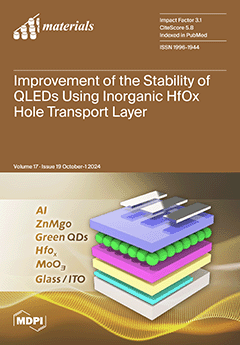Photoelectrochemically active WO
3 films were fabricated by electrodeposition from an acidic (pH 2), hydrogen-peroxide-containing electrolyte at −0.5 V vs. SCE. WO
3-TiO
2 composites were then synthesized under the same conditions, but with 0.2 g/L of anatase TiO
2 nanoparticles (⌀
[...] Read more.
Photoelectrochemically active WO
3 films were fabricated by electrodeposition from an acidic (pH 2), hydrogen-peroxide-containing electrolyte at −0.5 V vs. SCE. WO
3-TiO
2 composites were then synthesized under the same conditions, but with 0.2 g/L of anatase TiO
2 nanoparticles (⌀ 36 nm), mechanically suspended in the solution by stirring. After synthesis, the films were annealed at 400 °C. Structural characterization by XRD showed that the WO
3 films exhibit the crystalline structure of a non-stoichiometric hydrate, whereas, in WO
3-TiO
2, the WO
3 phase was monoclinic. The oxidation of tungsten, as revealed by XPS, was W
6+ for both materials. Ti was found to exist mainly as Ti
4+ in the composite, with a weak Ti
3+ signal. The efficiency of the WO
3 films and composites as an oxygen evolution reaction (OER) photo-electrocatalyst was examined. The composite would generate approximately three times larger steady-state photocurrents at 1.2 V vs. SCE in a neutral 0.5 M Na
2SO
4 electrolyte compared to WO
3 alone. The surface recombination of photogenerated electron–hole pairs was characterized by intensity-modulated photocurrent spectroscopy (IMPS). Photogenerated charge transfer efficiencies were calculated from the spectra, and at 1.2 V vs. SCE, were 86.6% for WO
3 and 62% for WO
3-TiO
2. Therefore, the composite films suffered from relatively more surface recombination but generated larger photocurrents, which resulted in overall improved photoactivity.
Full article






